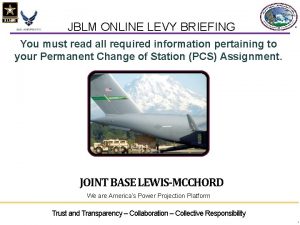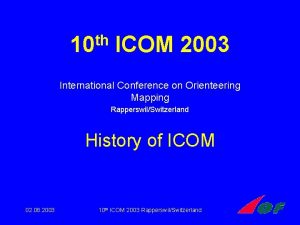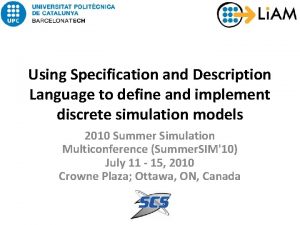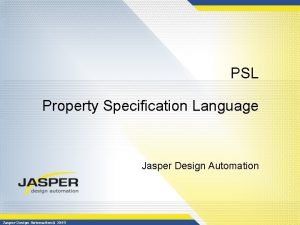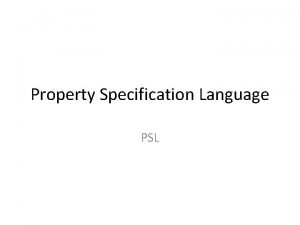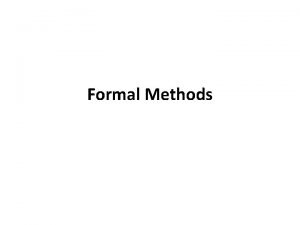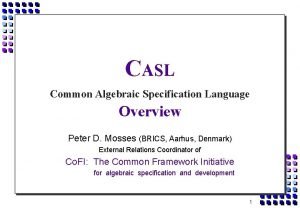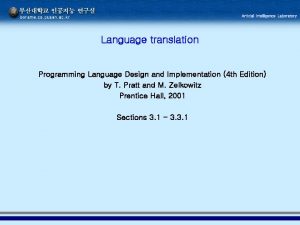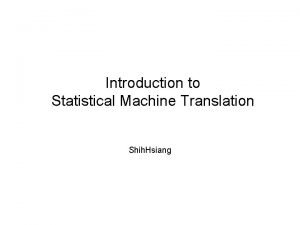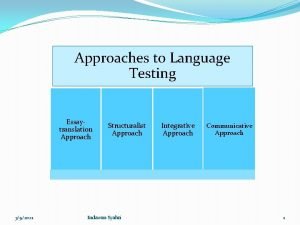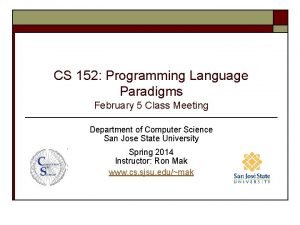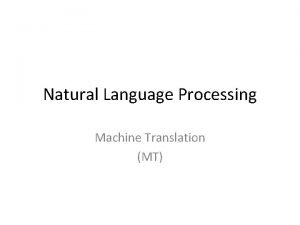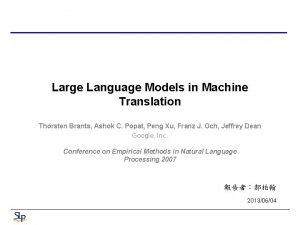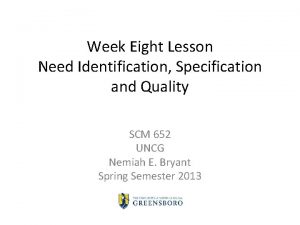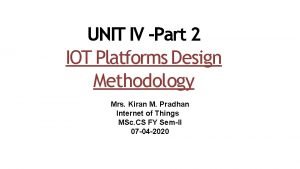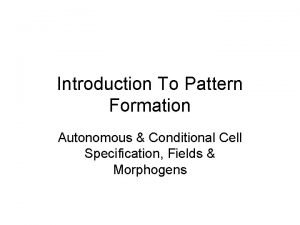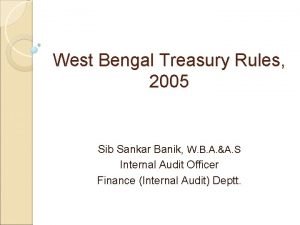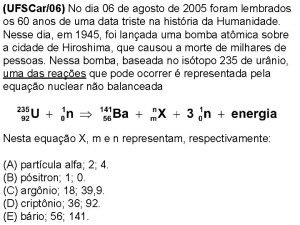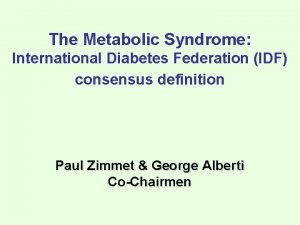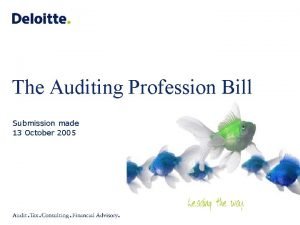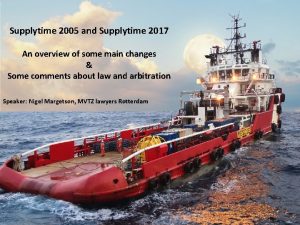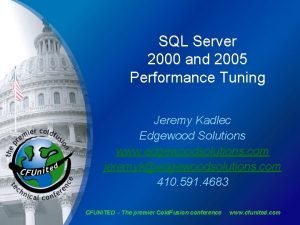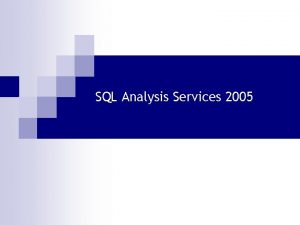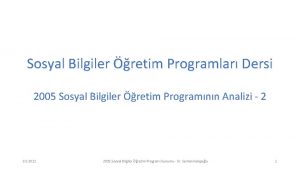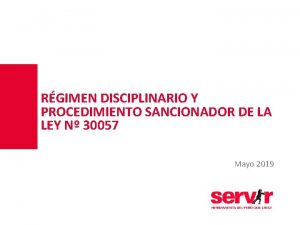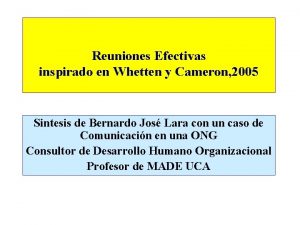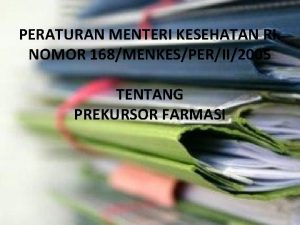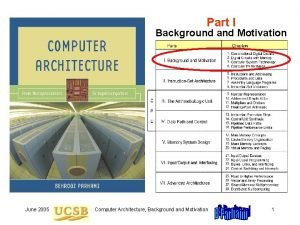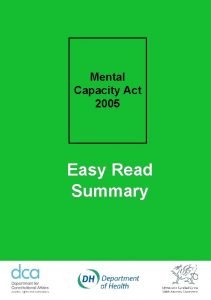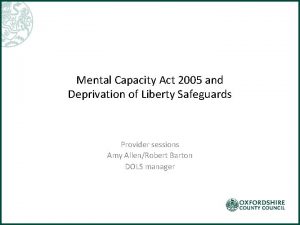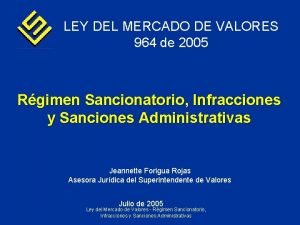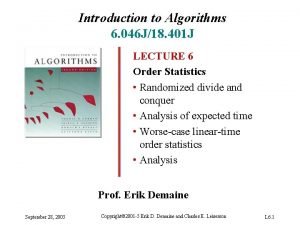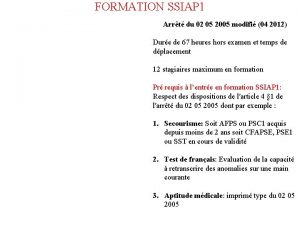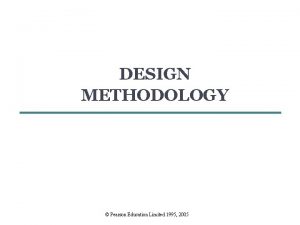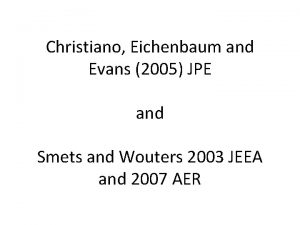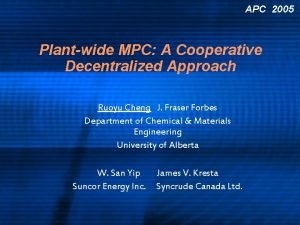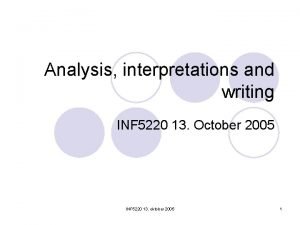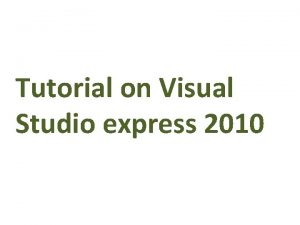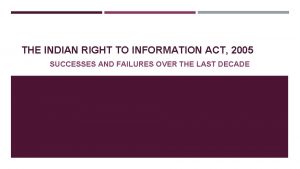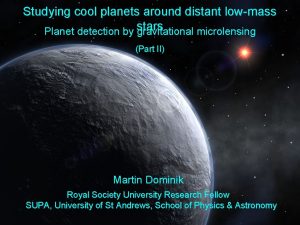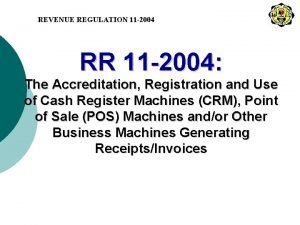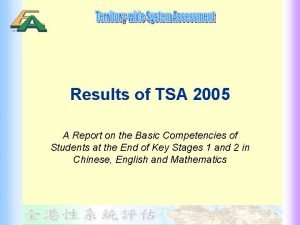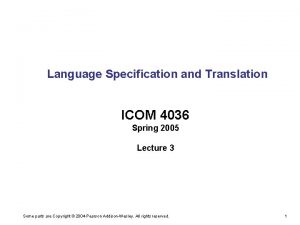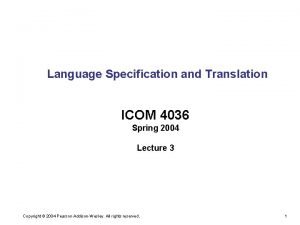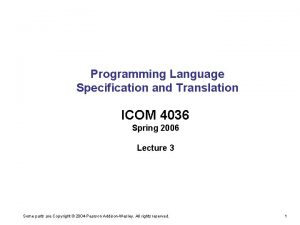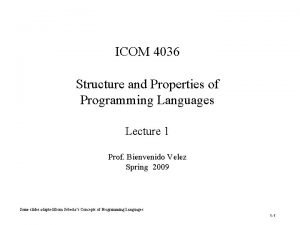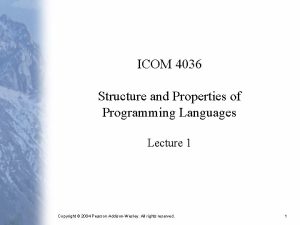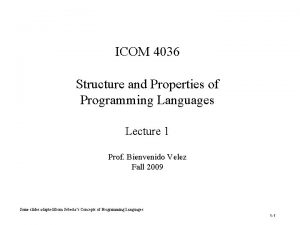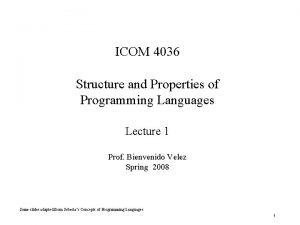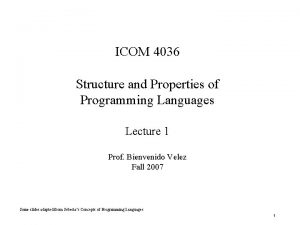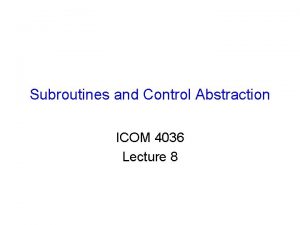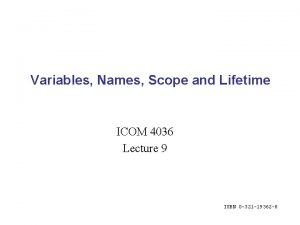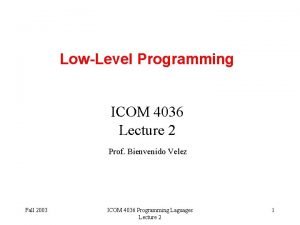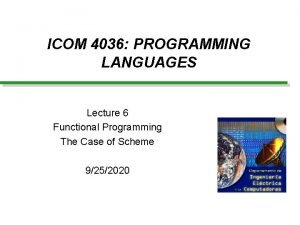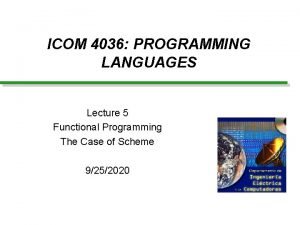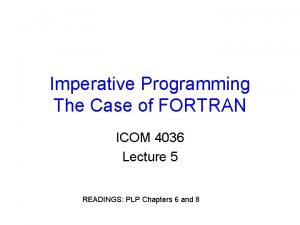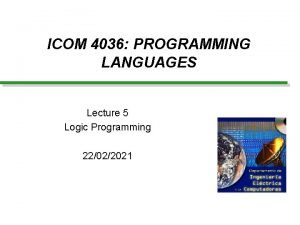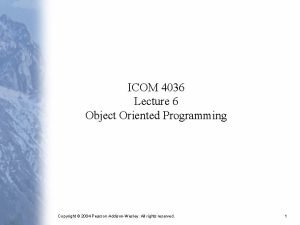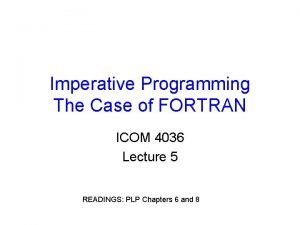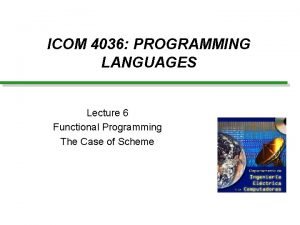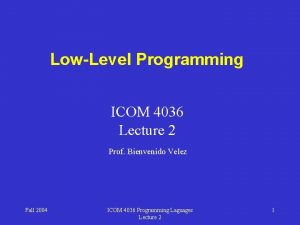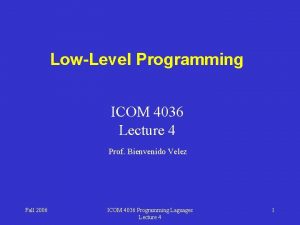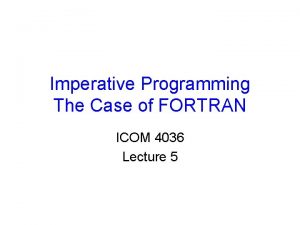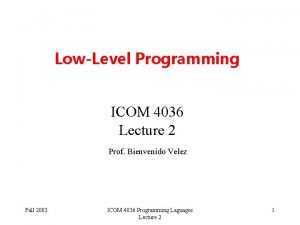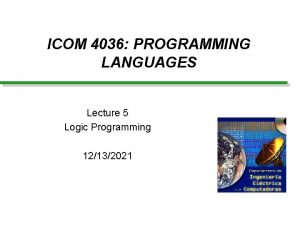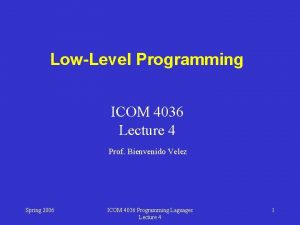Language Specification and Translation ICOM 4036 Fall 2005



















































![Recursive-Descent Parsing Left factoring can resolve the problem Replace: <variable> identifier | identifier [<expression>] Recursive-Descent Parsing Left factoring can resolve the problem Replace: <variable> identifier | identifier [<expression>]](https://slidetodoc.com/presentation_image/0151abe2444b4cc91f85d44223574332/image-52.jpg)





















![Bottom-up Parsing • Parser actions (continued): – If ACTION[Sm, ai] = Accept, the parse Bottom-up Parsing • Parser actions (continued): – If ACTION[Sm, ai] = Accept, the parse](https://slidetodoc.com/presentation_image/0151abe2444b4cc91f85d44223574332/image-74.jpg)










- Slides: 84

Language Specification and Translation ICOM 4036 Fall 2005 Lecture 3 Some parts are Copyright © 2004 Pearson Addison-Wesley. All rights reserved. 1

Language Specification and Translation Topics • • Structure of a Compiler Lexical Specification and Scanning Syntactic Specification and Parsing Semantic Specification and Analysis Some parts are Copyright © 2004 Pearson Addison-Wesley. All rights reserved. 2

Syntax versus Semantics • Syntax - the form or structure of the expressions, statements, and program units • Semantics - the meaning of the expressions, statements, and program units Some parts are Copyright © 2004 Pearson Addison-Wesley. All rights reserved. 3

The Structure of a Compiler 1. 2. 3. 4. 5. Lexical Analysis Parsing Semantic Analysis Optimization Code Generation The first 3, at least, can be understood by analogy to how humans comprehend English. Some parts are Copyright © 2004 Pearson Addison-Wesley. All rights reserved. 4

A Prototypical Compiler source Scanner tokens Parser AST Semantic Analysis IL Optimizer IL Code Generator Some parts are Copyright © 2004 Pearson Addison-Wesley. All rights reserved. exe 5

Introduction • Reasons to separate compiler in phases: – Simplicity - less complex approaches can be used for lexical analysis; separating them simplifies the parser – Efficiency - separation allows optimization of the lexical analyzer – Portability - parts of the lexical analyzer may not be portable, but the parser always is portable Some parts are Copyright © 2004 Pearson Addison-Wesley. All rights reserved. 6

Lexical Analysis • First step: recognize words. – Smallest unit above letters This is a sentence. • Note the – Capital “T” (start of sentence symbol) – Blank “ “ (word separator) – Period “. ” (end of sentence symbol) Some parts are Copyright © 2004 Pearson Addison-Wesley. All rights reserved. 7

Lexical Analysis • Lexical analysis is not trivial. Consider: ist his ase nte nce • Plus, programming languages are typically more cryptic than English: *p->f ++ = -. 12345 e-5 Some parts are Copyright © 2004 Pearson Addison-Wesley. All rights reserved. 8

Lexical Analysis • Lexical analyzer divides program text into “words” or “tokens” if x == y then z = 1; else z = 2; • Units: if, x, ==, y, then, z, =, 1, ; , else, z, =, 2, ; Some parts are Copyright © 2004 Pearson Addison-Wesley. All rights reserved. 9

Lexical Analysis • A lexical analyzer is a pattern matcher for character strings • A lexical analyzer is a “front-end” for the parser • Identifies substrings of the source program that belong together - lexemes – Lexemes match a character pattern, which is associated with a lexical category called a token – sum is a lexeme; its token may be IDENT Some parts are Copyright © 2004 Pearson Addison-Wesley. All rights reserved. 10

Lexical Analysis • The lexical analyzer is usually a function that is called by the parser when it needs the next token • Three approaches to building a lexical analyzer: – Write a formal description of the tokens and use a software tool that constructs table-driven lexical analyzers given such a description (e. g. lex) – Design a state diagram that describes the tokens and write a program that implements the state diagram – Design a state diagram that describes the tokens and handconstruct a table-driven implementation of the state diagram • We only discuss approach 2 State diagram = Finite State Machine Some parts are Copyright © 2004 Pearson Addison-Wesley. All rights reserved. 11

Pascal Scanner Finite State Diagram Some parts are Copyright © 2004 Pearson Addison-Wesley. All rights reserved. 12

Lexical Analysis • State diagram design: – A naïve state diagram would have a transition from every state on every character in the source language - such a diagram would be very large! • In many cases, transitions can be combined to simplify the state diagram – When recognizing an identifier, all uppercase and lowercase letters are equivalent • Use a character class that includes all letters – When recognizing an integer literal, all digits are equivalent - use a digit class Some parts are Copyright © 2004 Pearson Addison-Wesley. All rights reserved. 13

Lexical Analysis • Reserved words and identifiers can be recognized together (rather than having a part of the diagram for each reserved word) – Use a table lookup to determine whether a possible identifier is in fact a reserved word Some parts are Copyright © 2004 Pearson Addison-Wesley. All rights reserved. 14

Lexical Analysis • Convenient utility subprograms: – get. Char - gets the next character of input, puts it in next. Char, determines its class and puts the class in char. Class – add. Char - puts the character from next. Char into the place the lexeme is being accumulated, lexeme – lookup - determines whether the string in lexeme is a reserved word (returns a code) Some parts are Copyright © 2004 Pearson Addison-Wesley. All rights reserved. 15

State Diagram Some parts are Copyright © 2004 Pearson Addison-Wesley. All rights reserved. 16

Lexical Analysis Implementation (assume initialization): int lex() { get. Char(); switch (char. Class) { case LETTER: add. Char(); get. Char(); while (char. Class == LETTER || char. Class == DIGIT) { add. Char(); get. Char(); } return lookup(lexeme); break; case DIGIT: add. Char(); get. Char(); while (char. Class == DIGIT) { add. Char(); get. Char(); } return INT_LIT; break; } /* End of switch */ } /* End of function lex */ Some parts are Copyright © 2004 Pearson Addison-Wesley. All rights reserved. 17

Parsing • Once words are understood, the next step is to understand sentence structure • Parsing = Diagramming Sentences – The diagram is a tree Some parts are Copyright © 2004 Pearson Addison-Wesley. All rights reserved. 18

Diagramming a Sentence Thi s line article is noun verb a longer article adjective subject sentence noun object sentence Some parts are Copyright © 2004 Pearson Addison-Wesley. All rights reserved. 19

Parsing Programs • Parsing program expressions is the same • Consider: If x == y then z = 1; else z = 2; • Diagrammed: x == y z 1 z 2 relation assign predicate then-stmt else-stmt if-then-else Some parts are Copyright © 2004 Pearson Addison-Wesley. All rights reserved. 20

Describing Syntax • A sentence is a string of characters over some alphabet • A language is a set of sentences • A lexeme is the lowest level syntactic unit of a language (e. g. , *, sum, begin) • A token is a category of lexemes (e. g. , identifier) Some parts are Copyright © 2004 Pearson Addison-Wesley. All rights reserved. 21

Describing Syntax • Formal approaches to describing syntax: – Recognizers - used in compilers (we will look at in Chapter 4) – Generators – generate the sentences of a language (what we'll study in this chapter) Some parts are Copyright © 2004 Pearson Addison-Wesley. All rights reserved. 22

Formal Methods of Describing Syntax • Context-Free Grammars – Developed by Noam Chomsky in the mid-1950 s – Language generators, meant to describe the syntax of natural languages – Define a class of languages called context-free languages Some parts are Copyright © 2004 Pearson Addison-Wesley. All rights reserved. 23

Formal Methods of Describing Syntax • Backus-Naur Form (1959) – Invented by John Backus to describe Algol 58 – BNF is equivalent to context-free grammars – A metalanguage is a language used to describe another language. – In BNF, abstractions are used to represent classes of syntactic structures--they act like syntactic variables (also called nonterminal symbols) Some parts are Copyright © 2004 Pearson Addison-Wesley. All rights reserved. 24

Backus-Naur Form (1959) <while_stmt> while ( <logic_expr> ) <stmt> • This is a rule; it describes the structure of a while statement Some parts are Copyright © 2004 Pearson Addison-Wesley. All rights reserved. 25

Formal Methods of Describing Syntax • A rule has a left-hand side (LHS) and a right-hand side (RHS), and consists of terminal and nonterminal symbols • A grammar is a finite nonempty set of rules • An abstraction (or nonterminal symbol) can have more than one RHS <stmt> <single_stmt> | begin <stmt_list> end Some parts are Copyright © 2004 Pearson Addison-Wesley. All rights reserved. 26

Formal Methods of Describing Syntax • Syntactic lists are described using recursion <ident_list> ident | ident, <ident_list> • A derivation is a repeated application of rules, starting with the start symbol and ending with a sentence (all terminal symbols) Some parts are Copyright © 2004 Pearson Addison-Wesley. All rights reserved. 27

Formal Methods of Describing Syntax • An example grammar: <program> <stmts> <stmt> | <stmt> ; <stmts> <stmt> <var> = <expr> <var> a | b | c | d <expr> <term> + <term> | <term> <var> | const Some parts are Copyright © 2004 Pearson Addison-Wesley. All rights reserved. 28

Formal Methods of Describing Syntax • An example derivation: <program> => <stmts> => <stmt> => <var> = <expr> => a = <term> + <term> => a = <var> + <term> => a = b + const Some parts are Copyright © 2004 Pearson Addison-Wesley. All rights reserved. 29

Derivation • Every string of symbols in the derivation is a sentential form • A sentence is a sentential form that has only terminal symbols • A leftmost derivation is one in which the leftmost nonterminal in each sentential form is the one that is expanded • A derivation may be neither leftmost nor rightmost Some parts are Copyright © 2004 Pearson Addison-Wesley. All rights reserved. 30

Parse Tree • A hierarchical representation of a derivation <program> <stmts> <stmt> <var> = <expr> a <term>+ <term> <var> const b Some parts are Copyright © 2004 Pearson Addison-Wesley. All rights reserved. 31

Formal Methods of Describing Syntax • A grammar is ambiguous iff it generates a sentential form that has two or more distinct parse trees Some parts are Copyright © 2004 Pearson Addison-Wesley. All rights reserved. 32

An Ambiguous Expression Grammar <expr> <op> <expr> | const <op> / | <expr> <op> <expr><op><expr> const - const / <expr><op><expr> const Some parts are Copyright © 2004 Pearson Addison-Wesley. All rights reserved. const - const / const 33

An Unambiguous Expression Grammar • If we use the parse tree to indicate precedence levels of the operators, we cannot have ambiguity <expr> - <term> | <term> / const | const <expr> - <term> / const Some parts are Copyright © 2004 Pearson Addison-Wesley. All rights reserved. const 34

Formal Methods of Describing Syntax Derivation: <expr> => <expr> - <term> => <term> - <term> => const - <term> / const => const - const / const Some parts are Copyright © 2004 Pearson Addison-Wesley. All rights reserved. 35

Formal Methods of Describing Syntax • Operator associativity can also be indicated by a grammar <expr> -> <expr> + <expr> | const (ambiguous) <expr> -> <expr> + const | const (unambiguous) <expr> + const Some parts are Copyright © 2004 Pearson Addison-Wesley. All rights reserved. 36

Formal Methods of Describing Syntax • Extended BNF (just abbreviations): – Optional parts are placed in brackets ([ ]) <proc_call> -> ident [ ( <expr_list>)] – Put alternative parts of RHSs in parentheses and separate them with vertical bars <term> -> <term> (+ | -) const – Put repetitions (0 or more) in braces ({ }) <ident> -> letter {letter | digit} Some parts are Copyright © 2004 Pearson Addison-Wesley. All rights reserved. 37

BNF and EBNF • BNF: <expr> + <term> | <expr> - <term> | <term> * <factor> | <term> / <factor> | <factor> • EBNF: <expr> <term> {(+ | -) <term>} <term> <factor> {(* | /) <factor>} Some parts are Copyright © 2004 Pearson Addison-Wesley. All rights reserved. 38

The Parsing Problem • Goals of the parser, given an input program: – Find all syntax errors; for each, produce an appropriate diagnostic message, and recover quickly – Produce the parse tree, or at least a trace of the parse tree, for the program Some parts are Copyright © 2004 Pearson Addison-Wesley. All rights reserved. 39

The Parsing Problem • Two categories of parsers – Top down - produce the parse tree, beginning at the root • Order is that of a leftmost derivation – Bottom up - produce the parse tree, beginning at the leaves • Order is that of the reverse of a rightmost derivation • Parsers look only one token ahead in the input Some parts are Copyright © 2004 Pearson Addison-Wesley. All rights reserved. 40

The Parsing Problem • Top-down Parsers – Given a sentential form, x. A , the parser must choose the correct A-rule to get the next sentential form in the leftmost derivation, using only the first token produced by A • The most common top-down parsing algorithms: – Recursive descent - a coded implementation – LL parsers - table driven implementation Some parts are Copyright © 2004 Pearson Addison-Wesley. All rights reserved. 41

The Parsing Problem • Bottom-up parsers – Given a right sentential form, , determine what substring of is the right-hand side of the rule in the grammar that must be reduced to produce the previous sentential form in the right derivation – The most common bottom-up parsing algorithms are in the LR family Some parts are Copyright © 2004 Pearson Addison-Wesley. All rights reserved. 42

The Parsing Problem • The Complexity of Parsing – Parsers that work for any unambiguous grammar are complex and inefficient ( O(n 3), where n is the length of the input ) – Compilers use parsers that only work for a subset of all unambiguous grammars, but do it in linear time ( O(n), where n is the length of the input ) Some parts are Copyright © 2004 Pearson Addison-Wesley. All rights reserved. 43

Recursive-Descent Parsing • Recursive Descent Process – There is a subprogram for each nonterminal in the grammar, which can parse sentences that can be generated by that nonterminal – EBNF is ideally suited for being the basis for a recursive-descent parser, because EBNF minimizes the number of nonterminals Some parts are Copyright © 2004 Pearson Addison-Wesley. All rights reserved. 44

Recursive-Descent Parsing • A grammar for simple expressions: <expr> <term> {(+ | -) <term>} <term> <factor> {(* | /) <factor>} <factor> id | ( <expr> ) Some parts are Copyright © 2004 Pearson Addison-Wesley. All rights reserved. 45

Recursive-Descent Parsing • Assume we have a lexical analyzer named lex, which puts the next token code in next. Token • The coding process when there is only one RHS: – For each terminal symbol in the RHS, compare it with the next input token; if they match, continue, else there is an error – For each nonterminal symbol in the RHS, call its associated parsing subprogram Some parts are Copyright © 2004 Pearson Addison-Wesley. All rights reserved. 46

Recursive-Descent Parsing /* Function expr Parses strings in the language generated by the rule: <expr> → <term> {(+ | -) <term>} */ void expr() { /* Parse the first term */ term(); /* As long as the next token is + or -, call lex to get the next token, and parse the next term */ while (next. Token == PLUS_CODE || next. Token == MINUS_CODE){ lex(); term(); } } • This particular routine does not detect errors • Convention: Every parsing routine leaves the next token in next. Token Some parts are Copyright © 2004 Pearson Addison-Wesley. All rights reserved. 47

Recursive-Descent Parsing • A nonterminal that has more than one RHS requires an initial process to determine which RHS it is to parse – The correct RHS is chosen on the basis of the next token of input (the lookahead) – The next token is compared with the first token that can be generated by each RHS until a match is found – If no match is found, it is a syntax error Some parts are Copyright © 2004 Pearson Addison-Wesley. All rights reserved. 48

Recursive-Descent Parsing /* Function factor Parses strings in the language generated by the rule: <factor> -> id | (<expr>) */ void factor() { /* Determine which RHS */ if (next. Token) == ID_CODE) /* For the RHS id, just call lex */ lex(); /* If the RHS is (<expr>) – call lex to pass over the left parenthesis, call expr, and check for the right parenthesis */ else if (next. Token == LEFT_PAREN_CODE) { lex(); expr(); if (next. Token == RIGHT_PAREN_CODE) lex(); else error(); } /* End of else if (next. Token ==. . . */ else error(); /* Neither RHS matches */ } Some parts are Copyright © 2004 Pearson Addison-Wesley. All rights reserved. 49

Recursive-Descent Parsing • Limitations of the LL grammar classes – The Left Recursion Problem • If a grammar has left recursion, either direct or indirect, it cannot be the basis for a top-down parser – A grammar can be modified to remove left recursion – Lack of pairwise disjointness • The inability to determine the correct RHS on the basis of one token of lookahead • Def: FIRST( ) = {a | =>* a } (If =>* , is in FIRST( )) Some parts are Copyright © 2004 Pearson Addison-Wesley. All rights reserved. 50

Recursive-Descent Parsing • Pairwise Disjointness Test: – For each nonterminal, A, in the grammar that has more than one RHS, for each pair of rules, A i and A j, it must be true that FIRST( i) FIRST( j) = • Examples: A a | b. B | c. Ab A a | a. B Some parts are Copyright © 2004 Pearson Addison-Wesley. All rights reserved. 51
![RecursiveDescent Parsing Left factoring can resolve the problem Replace variable identifier identifier expression Recursive-Descent Parsing Left factoring can resolve the problem Replace: <variable> identifier | identifier [<expression>]](https://slidetodoc.com/presentation_image/0151abe2444b4cc91f85d44223574332/image-52.jpg)
Recursive-Descent Parsing Left factoring can resolve the problem Replace: <variable> identifier | identifier [<expression>] With: <variable> identifier <new> | [<expression>] Some parts are Copyright © 2004 Pearson Addison-Wesley. All rights reserved. 52

Bottom-up Parsing • The parsing problem is finding the correct RHS in a right-sentential form to reduce to get the previous right-sentential form in the derivation Some parts are Copyright © 2004 Pearson Addison-Wesley. All rights reserved. 53

Bottom-up Parsing • The parsing problem is finding the correct RHS in a rightsentential form to reduce to get the previous right-sentential form in the derivation • Intuition about handles: – Def: is the handle of the right sentential form = w if and only if S =>*rm Aw =>rm w – Def: is a phrase of the right sentential form if and only if S =>* = 1 A 2 =>+ 1 2 – Def: is a simple phrase of the right sentential form if and only if S =>* = 1 A 2 => 1 2 Some parts are Copyright © 2004 Pearson Addison-Wesley. All rights reserved. 54

A Bottom-up Parse in Detail (1) E E+(E) E int + (int) int + ( Some parts are Copyright © 2004 Pearson Addison-Wesley. All rights reserved. int ) + ( int ) 55

A Bottom-up Parse in Detail (2) E E+(E) E int + (int) E int + ( Some parts are Copyright © 2004 Pearson Addison-Wesley. All rights reserved. int ) + ( int ) 56

A Bottom-up Parse in Detail (3) E E+(E) E int + (int) E + (E) + (int) E int E + ( Some parts are Copyright © 2004 Pearson Addison-Wesley. All rights reserved. int ) + ( int ) 57

A Bottom-up Parse in Detail (4) E E+(E) E int + (int) E + (E) + (int) E E int E + ( Some parts are Copyright © 2004 Pearson Addison-Wesley. All rights reserved. int ) + ( int ) 58

A Bottom-up Parse in Detail (5) E E+(E) E int + (int) E + (E) + (int) E + (E) E E int E E + ( Some parts are Copyright © 2004 Pearson Addison-Wesley. All rights reserved. int ) + ( int ) 59

A Bottom-up Parse in Detail (6) E E+(E) E int E int + (int) E + (E) + (int) E + (E) E A rightmost derivation in reverse E E int E E + ( Some parts are Copyright © 2004 Pearson Addison-Wesley. All rights reserved. int ) + ( int ) 60

Bottom-up Parsing • Advantages of LR parsers: – They will work for nearly all grammars that describe programming languages. – They work on a larger class of grammars than other bottom-up algorithms, but are as efficient as any other bottom-up parser. – They can detect syntax errors as soon as it is possible. – The LR class of grammars is a superset of the class parsable by LL parsers. Some parts are Copyright © 2004 Pearson Addison-Wesley. All rights reserved. 61

Classes of grammars Some parts are Copyright © 2004 Pearson Addison-Wesley. All rights reserved. 62

Semantic Analysis • Once sentence structure is understood, we can try to understand “meaning” – But meaning is too hard for compilers • Compilers perform limited analysis to catch inconsistencies • Some do more analysis to improve the performance of the program Some parts are Copyright © 2004 Pearson Addison-Wesley. All rights reserved. 63

Semantic Analysis in English • Example: Jack said Jerry left his assignment at home. What does “his” refer to? Jack or Jerry? • Even worse: Jack said Jack left his assignment at home? How many Jacks are there? Which one left the assignment? Some parts are Copyright © 2004 Pearson Addison-Wesley. All rights reserved. 64

Semantic Analysis in Programming • Programming languages define strict rules to avoid such ambiguities { • This C++ code prints “ 4”; the inner } definition is used int Jack = 3; { int Jack = 4; cout << Jack; } Some parts are Copyright © 2004 Pearson Addison-Wesley. All rights reserved. 65

More Semantic Analysis • Compilers perform many semantic checks besides variable bindings • Example: Jack left her homework at home. • A “type mismatch” between her and Jack; we know they are different people – Presumably Jack is male Some parts are Copyright © 2004 Pearson Addison-Wesley. All rights reserved. 66

Static Semantic Analysis • Types of Checks conducted by compiler: 1. All identifiers are declared 2. Types 3. Inheritance relationships 4. Classes defined only once 5. Methods in a class defined only once 6. Reserved identifiers are not misused And others. . . • Complex languages => Complex checks • Algorithm: Traverse the AST produced by the parser Some parts are Copyright © 2004 Pearson Addison-Wesley. All rights reserved. 67

END OF ICOM 4036 LECTURE 3 Some parts are Copyright © 2004 Pearson Addison-Wesley. All rights reserved. 68

Bottom-up Parsing • LR parsers must be constructed with a tool • Knuth’s insight: A bottom-up parser could use the entire history of the parse, up to the current point, to make parsing decisions – There were only a finite and relatively small number of different parse situations that could have occurred, so the history could be stored in a parser state, on the parse stack Some parts are Copyright © 2004 Pearson Addison-Wesley. All rights reserved. 69

Bottom-up Parsing • An LR configuration stores the state of an LR parser (S 0 X 1 S 1 X 2 S 2…Xm. Sm, aiai+1…an$) Some parts are Copyright © 2004 Pearson Addison-Wesley. All rights reserved. 70

Bottom-up Parsing • LR parsers are table driven, where the table has two components, an ACTION table and a GOTO table – The ACTION table specifies the action of the parser, given the parser state and the next token • Rows are state names; columns are terminals – The GOTO table specifies which state to put on top of the parse stack after a reduction action is done • Rows are state names; columns are nonterminals Some parts are Copyright © 2004 Pearson Addison-Wesley. All rights reserved. 71

Structure of An LR Parser Some parts are Copyright © 2004 Pearson Addison-Wesley. All rights reserved. 72

Bottom-up Parsing • Initial configuration: (S 0, a 1…an$) • Parser actions: – If ACTION[Sm, ai] = Shift S, the next configuration is: (S 0 X 1 S 1 X 2 S 2…Xm. Smai. S, ai+1…an$) – If ACTION[Sm, ai] = Reduce A and S = GOTO[Sm-r, A], where r = the length of , the next configuration is (S 0 X 1 S 1 X 2 S 2…Xm-r. Sm-r. AS, aiai+1…an$) Some parts are Copyright © 2004 Pearson Addison-Wesley. All rights reserved. 73
![Bottomup Parsing Parser actions continued If ACTIONSm ai Accept the parse Bottom-up Parsing • Parser actions (continued): – If ACTION[Sm, ai] = Accept, the parse](https://slidetodoc.com/presentation_image/0151abe2444b4cc91f85d44223574332/image-74.jpg)
Bottom-up Parsing • Parser actions (continued): – If ACTION[Sm, ai] = Accept, the parse is complete and no errors were found. – If ACTION[Sm, ai] = Error, the parser calls an error-handling routine. Some parts are Copyright © 2004 Pearson Addison-Wesley. All rights reserved. 74

LR Parsing Table Some parts are Copyright © 2004 Pearson Addison-Wesley. All rights reserved. 75

Bottom-up Parsing • A parser table can be generated from a given grammar with a tool, e. g. , yacc Some parts are Copyright © 2004 Pearson Addison-Wesley. All rights reserved. 76

Optimization • No strong counterpart in English, but akin to editing • Automatically modify programs so that they – Run faster – Use less memory – In general, conserve some resource • The project has no optimization component Some parts are Copyright © 2004 Pearson Addison-Wesley. All rights reserved. 77

Optimization Example X = Y * 0 is the same as X = 0 NO! Valid for integers, but not for floating point numbers Some parts are Copyright © 2004 Pearson Addison-Wesley. All rights reserved. 78

Code Generation • Produces assembly code (usually) • A translation into another language – Analogous to human translation Some parts are Copyright © 2004 Pearson Addison-Wesley. All rights reserved. 79

Intermediate Languages • Many compilers perform translations between successive intermediate forms – All but first and last are intermediate languages internal to the compiler – Typically there is 1 IL • IL’s generally ordered in descending level of abstraction – Highest is source – Lowest is assembly Some parts are Copyright © 2004 Pearson Addison-Wesley. All rights reserved. 80

Intermediate Languages (Cont. ) • IL’s are useful because lower levels expose features hidden by higher levels – registers – memory layout – etc. • But lower levels obscure high-level meaning Some parts are Copyright © 2004 Pearson Addison-Wesley. All rights reserved. 81

Issues • Compiling is almost this simple, but there are many pitfalls. • Example: How are erroneous programs handled? • Language design has big impact on compiler – Determines what is easy and hard to compile – Course theme: many trade-offs in language design Some parts are Copyright © 2004 Pearson Addison-Wesley. All rights reserved. 82

Compilers Today • The overall structure of almost every compiler adheres to our outline • The proportions have changed since FORTRAN – Early: lexing, parsing most complex, expensive – Today: optimization dominates all other phases, lexing and parsing are cheap Some parts are Copyright © 2004 Pearson Addison-Wesley. All rights reserved. 83

Trends in Compilation • Compilation for speed is less interesting. But: – scientific programs – advanced processors (Digital Signal Processors, advanced speculative architectures) • Ideas from compilation used for improving code reliability: – memory safety – detecting concurrency errors (data races) –. . . Some parts are Copyright © 2004 Pearson Addison-Wesley. All rights reserved. 84
 Reassignments jblm
Reassignments jblm Yaesu ftm-400xdr vs icom 5100
Yaesu ftm-400xdr vs icom 5100 Papasys
Papasys ämaps
ämaps Icom model project management
Icom model project management If lclp is negative number, we set the lclp = 0. why?
If lclp is negative number, we set the lclp = 0. why? Limites de control
Limites de control Difference between semantic and communicative translation
Difference between semantic and communicative translation Linear function transformations
Linear function transformations Sdl specification and description language
Sdl specification and description language Voice translation-rule
Voice translation-rule Noun phrases
Noun phrases Property specification language
Property specification language Hardware specification example
Hardware specification example Types of formal methods
Types of formal methods Common algebraic specification language
Common algebraic specification language Language design and translation issues
Language design and translation issues Identifying sounds of poetry #1
Identifying sounds of poetry #1 Spanish to english
Spanish to english The essay translation approach
The essay translation approach Language translation
Language translation What is source text
What is source text Language translation
Language translation Record3d
Record3d Machine translation in natural language processing
Machine translation in natural language processing Large language models in machine translation
Large language models in machine translation Counseling process stages
Counseling process stages Clean neighbourhoods and environment act 2005 dog fouling
Clean neighbourhoods and environment act 2005 dog fouling Need identification and specification
Need identification and specification Participant diary/logs
Participant diary/logs Difference between job description and job analysis
Difference between job description and job analysis Iot system design methodology
Iot system design methodology Autonomous vs conditional specification
Autonomous vs conditional specification Software requirement analysis and specification
Software requirement analysis and specification Richard nixon tricky dicky
Richard nixon tricky dicky Treasury rules 2005
Treasury rules 2005 Lida jacob ias
Lida jacob ias 5 mca principles
5 mca principles No dia 06 de agosto de 2005 foram lembrados
No dia 06 de agosto de 2005 foram lembrados Sfs-en 1838
Sfs-en 1838 Idf 2005
Idf 2005 Reportable irregularity template
Reportable irregularity template Supplytime 2005
Supplytime 2005 How to monitor log shipping in sql server 2005
How to monitor log shipping in sql server 2005 Sql server 2005 performance monitor
Sql server 2005 performance monitor Microsoft sql server 2005 analysis services
Microsoft sql server 2005 analysis services 2005 sosyal bilgiler öğretim programı
2005 sosyal bilgiler öğretim programı Informe técnico 1005-2018-servir-gpgsc
Informe técnico 1005-2018-servir-gpgsc Whetten y cameron (2005)
Whetten y cameron (2005) Reporting services 2005
Reporting services 2005 Rumus lokakarya ppni
Rumus lokakarya ppni Permenkes nomor 168 tahun 2005 mengatur tentang
Permenkes nomor 168 tahun 2005 mengatur tentang June 2005 calendar
June 2005 calendar One source multi use
One source multi use Campinas 2005 car accident
Campinas 2005 car accident Existanxe
Existanxe Curricular areas of ncf 2005
Curricular areas of ncf 2005 Mental capacity act 2005 summary
Mental capacity act 2005 summary Mental capacity act 2005 summary
Mental capacity act 2005 summary Ley 964 de 2005
Ley 964 de 2005 2005/lml/18/8
2005/lml/18/8 S/2005 j18
S/2005 j18 Child rights act 2005 images
Child rights act 2005 images 02/05/2005
02/05/2005 Dubai 1960 and now
Dubai 1960 and now Visual studio 2005 tools
Visual studio 2005 tools Pearson education limited 2005
Pearson education limited 2005 4725
4725 Christiano eichenbaum evans 2005
Christiano eichenbaum evans 2005 2005 pearson prentice hall inc
2005 pearson prentice hall inc Elsevier 2005
Elsevier 2005 Biology 30 diploma
Biology 30 diploma Disability act 2005 citizens information
Disability act 2005 citizens information Apc 2005
Apc 2005 13 october 2005
13 october 2005 Altobeli lobodally
Altobeli lobodally Elsevier 2005
Elsevier 2005 School calendar 2005-2006
School calendar 2005-2006 Visual studio 2010 tutorial
Visual studio 2010 tutorial Rti act 2005 introduction
Rti act 2005 introduction Moon 18.05.2005
Moon 18.05.2005 Xena planet
Xena planet Ogle-2005-blg-390
Ogle-2005-blg-390 Sworn statement for esales registration
Sworn statement for esales registration Tsa 2005
Tsa 2005
